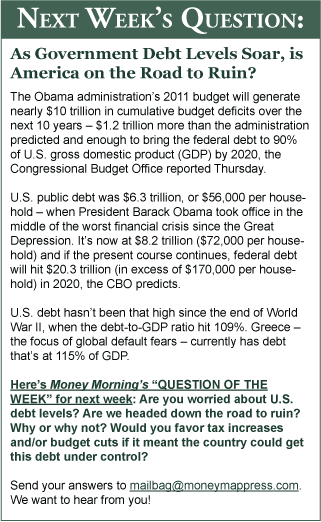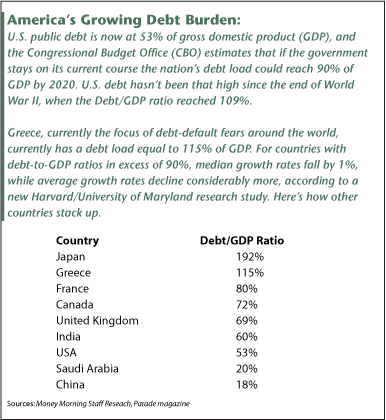Will America Choke on its Own Debt
According to a new estimate by the Congressional Budget Office (CBO), if the United States continues along its current path, U.S. public debt will reach 90% of the nation’s economic output by 2020.
Given that federal debt has already zoomed to 53% of gross domestic product (GDP), this projected additional escalation seems outrageous.
Unfortunately, it’s only a piece of the story.
 U.S. President Barack Obama’s Fiscal 2011 budget will generate nearly $10 trillion in cumulative budget deficits over the next 10 years. That’s $1.2 trillion more than the administration projected, and will be enough to boost federal debt to 90% of U.S. GDP by 2020, the CBO reported last week.
U.S. President Barack Obama’s Fiscal 2011 budget will generate nearly $10 trillion in cumulative budget deficits over the next 10 years. That’s $1.2 trillion more than the administration projected, and will be enough to boost federal debt to 90% of U.S. GDP by 2020, the CBO reported last week.
Back in early February, when the White House Office of Management and Budget (OMB) released its Fiscal 2011 budget, the Obama administration projected a 10-year deficit total of $8.53 trillion. The CBO studied that budget and the deficit figures, and concluded they were low – estimating that President Obama’s budget would generate a combined $9.75 trillion in deficits over the next decade.
Granted, the Obama administration came into office amid the worst financial crisis since the Great Depression. U.S. public debt was $6.3 trillion, or $56,000 per household, when President Obama took the oath of office. A little more than a year later, federal debt has reached $8.2 trillion ($72,000 per household). And if the CBO estimates are correct, the nation’s debt burden will reach $20.3 trillion (more than $170,000 per household) in 2020, reports The Washington Times.
At $20.3 trillion, the nation’s debt would be equal to 90% of the projected U.S. GDP for 2020 – up from 40% of GDP at the end of 2008 and 53% right now.
America’s debt-to-GDP ratio hasn’t been near the 100% level since the end of World War II, when it peaked at 109%. If you want a point of comparison, Greece, the debt-default candidate du jour, saw its debt load hit 115% of GDP last year.
Does this even matter … or is it just a game of numbers?
If it doesn’t matter now, it will later on as the U.S. debt burden continues to increase. In fact, a new research study seems to indicate that the high debt load could crimp future U.S. economic growth. The recent research study – conducted by economists Kenneth S. Rogoff of Harvard and Carmen M. Reinhart of the University of Maryland – found that for countries with debt-to-GDP ratios “above 90%, median growth rates fall by 1%, and average growth falls considerably more.”

According to the National Bureau of Economic Research (NBER), public-debt levels that reach or exceed 90% of GDP become highly problematic: The rising debt levels have likely caused interest rates to rise, because worried investors demand greater returns on federal bonds, while the massive interest payments required to service all that debt divert money away from other important government programs and other federal functions.
Says Isabel Sawhill of the Brookings Institution: “The interest can get so burdensome that the country can’t afford to repair its highways or educate its children or provide other essential services. You become a much weaker nation.”




